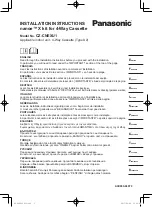
Commercial Air Conditioner
Model: heat pump, 10SEER UNITS
39
A. suction pressure holds.
normal condition.
B. Suction pressure rises to a point and stops.
.
Some refrigerant finally evaporated in the coil and made its pressure felt on the gauge .
Normal
condition .Do not start the compressor
to force this little refrigerant into the condenser.
C. Suction pressure rises and eventually equalizes with the high pressure .
Abnormal condition.
. Refrigerant is leaking from the condenser coil .
Causes
:Leaking liquid line valve, leaking discharge check valve (scroll compressors only ),
leaking compressor valves.
ACTION
: Determine the causes and correct it.
D
. Suction pressure Never drops to 3-5 PSI.
Abnormal condition.
Refrigerant is leaking from the
condenser coil .
Causes
:Leaking liquid line valve, leaking discharge check valve (scroll compressors only ),
leaking compressor valves.
ACTION
: Determine the causes and correct it..
REFRIGERANT NONCONDENSIBILES CHECK
This procedure checks the quality of the refrigerant by comparing the refrigerant pressure to its
temperature .The test tells if there are contaminating non-condensable gases in the refrigerant ,usually
air and moisture ,or if the proper refrigerant is in the system.
Table
Temperature Pressure Chart
TEMP
Deg F
R22
TEMP
Deg F
R22
TEMP
Deg F
R22
TEMP
Deg F
R22
-150
-140
-130
-120
-110
-100
-90
-80
-70
-60
-50
-40
-35
*29.4
*29.1
*28.5
*27.7
*26.6
*25.1
*23.0
*20.2
*16.6
*11.9
*6.1
0.6
2.6
-30
-25
-20
-15
-10
-5
0
5
10
15
20
25
30
4.9
7.5
10.2
13.2
16.5
20.1
24.0
28.3
32.8
37.8
43.1
48.8
54.9
35
40
45
50
55
60
65
70
75
80
85
90
95
61.5
68.5
76.1
84.1
92.6
101.6
111.3
121.4
132.2
143.7
155.7
168.4
181.8
100
105
110
115
120
125
130
135
140
145
150
196.1
210.8
226.4
242.8
260.8
278.0
297.0
316.7
337.4
359.1
381.7
Table 10-1
1. Pump the system down as the explained in the previous procedure. open the unit disconnect to
SHUT Down the system when the suction pressure drops to 3-5 psi positive pressure .
2. Front SEAT THE LARGE VAPOR LINE VALVE.
3. De-energize the compressor .
REMOVE EACH WIRE FROM THE COMPRESSOR
TERMINALS .MARK AND IDENTIFY THE WIRE TERMINALS.
WARNING :WRAP A LAYER OF INSULATION ELECTRICAL TAPE OVER THE WIRE TERMINALS ,
NOT THE COMPRESSOR TERMINALS .THIS WIRE END IS HOT WITH VOLTAGE DURING THE
REMINDER OF THE TEST .
4. Energize the system and run the condensing fan .Measure the condensing coil entering and leaving
air temperature with accurate thermometers.
5. Run the condensing fan until the leaving air temperature equals to the entering air temperature. This
is now the refrigerant temperature .
6. Compare the refrigerant pressure shown on the high pressure gauge to its associated pressure on a
temperature –pressure conversion chart.
7. The refrigerant pressure should equal the chart pressure for the given temperature.
A. The system pressure is above the chart pressure.
Cause
:Non-condensales are present –air






































